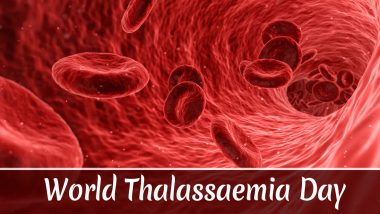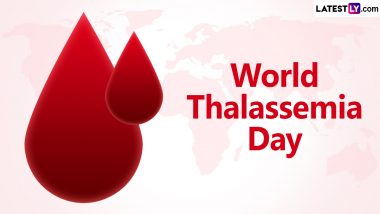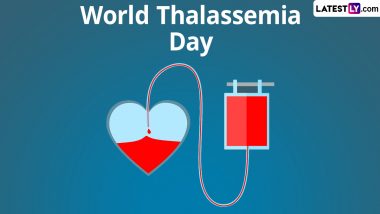Every year, World Thalassemia Day is celebrated on May 8. The day is dedicated to people with Thalassemia. It also encourages them to fight the disease and also runs campaigns to help them in their struggle with the blood disorder. Statistics say that about 20 percent of the world population carries α+ thalassaemia and about 1.1 percent of couples are at risk for having children with a haemoglobin disorder. Thalassemia is a blood disorder that is inherited. Cyberabad Cops Donate Blood for Thalassemia Patients.
The condition causes the body's ability to produce haemoglobin to go for a toss. It impacts the production of red blood cells in the body. Thalassemia patients have a scarcity of red blood cells and very little haemoglobin. Depending on the type of Thalasemmia, the impact of blood disorder can range from mild to severe and fatal. Let's discuss the types of Thalassemia. Four alpha-globin and two beta-globin protein chains make up haemoglobin and depending on the body's inability to produce these may cause thalassemia. The two main types of thalassemia are alpha and beta. Know in detail. World Thalassemia Day: Hrithik Roshan, Abhishek Bachchan, Sonakshi Sinha Spread Awareness with their Tweets.
Alpha Thalassemia
When the body is not able to produce alpha protein for haemoglobin, the person has alpha thalassemia. Alpha thalassemia is more commonly found in people from southern China, Southeast Asia, India and the Middle East. Akshay Kumar, Tiger Shroff to Spread Awareness on Prevention of Thalassemia.
The severity of thalassemia depends on how many genes are faulty, or mutated which means if a person has one faulty gene, they won't have any symptom. It is also called alpha thalassemia minima. Someone with two faulty genes will have mild anaemia and this type is called alpha thalassemia minor. With three faulty genes, one can have haemoglobin H disease.
Someone with four faulty genes will have alpha thalassemia major and it is the most severe form of alpha thalassemia. A fetus with four mutated genes cannot produce normal haemoglobin and usually doesn't survive.
Beta Thalassemia
A person needs two globin genes from each one of the parents to make beta-globin chains and If one or both genes are faulty, the person may have beta-thalassemia. This type of thalassemia is found more commonly in people having a Mediterranean ancestry aka in North Africa, West Asia, and the Maldive Islands. The severity of the disorder depends on how many genes are mutated and if one gene is faulty the person may have a beta-thalassemia minor. Whereas people with two faulty genes may have thalassemia major, also known as Colley’s anaemia.
Annually about 100,000 newborns have severe forms of thalassemia. Treatment methods include Blood transfusions that allow haemoglobin and red blood cell levels to be increased by external infusion. Some times iron chelation is also used as a method of treatment that includes removing excess iron from the bloodstream. Bone marrow, or stem cell transplant is another way to go. The bone marrow cells help the body produce red and white blood cells, haemoglobin, and platelets. Often patients also undergo surgeries to correct bone abnormalities. Scientists are studying gene therapy to treat thalassemia.
(The above story first appeared on LatestLY on May 07, 2020 08:48 PM IST. For more news and updates on politics, world, sports, entertainment and lifestyle, log on to our website latestly.com).













 Quickly
Quickly





















